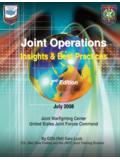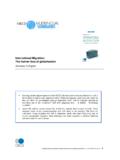Transcription of FOR INSTRUCTIONAL QUALITY - OECD.org
1 TEACHING STRATEGIESFOR INSTRUCTIONAL QUALITYINSIGHTS FROM THE TALIS-PISA LINK DATAThis work is published under the responsibility of the Secretary-General of the OECD. The opinions expressed and the arguments employed herein do not necessarily reflect the official views of OECD member document and any map included herein are without prejudice to the status of or sovereignty over any territory, to the delimitation of international frontiers and boundaries and to the name of any territory, city or can copy, download or print OECD content for your own use, and you can include excerpts from OECD publications, databases and multimedia products in your own documents, presentations, blogs, websites and teaching materials, provided that suitable acknowledgment of OECD as source and copyright owner is given.
2 All requests for commercial use and translation rights should be submitted to OECD 2016 Photo credits: Shutterstock/Kzenon Hero Images/Corbis Khoa vu/Flickr/Getty ImagesHadi Davodpour, CC0 Universal (CC0 ) OECD 2016 insights FROM THE TALIS-PISA LINK DATA: TEACHING STRATEGIES FOR INSTRUCTIONAL QUALITY3 The OECD study Teaching Strategies for INSTRUCTIONAL QUALITY is based on the analysis of the TALIS-PISA Link Teaching and Learning International Student Survey (TALIS) is an international survey that examines teaching and learning environments in schools in countries and economies around the world, while the Programme for International Student Assessment (PISA) assesses the extent to which children near the end of compulsory education have acquired the knowledge and skills needed for full participation in modern TALIS 2013, participating countries and economies had the option of applying TALIS questionnaires to a PISA 2012 subsample with the purpose of linking data on schools, teachers and students.
3 This option is called the TALIS-PISA Link database. The TALIS-PISA Link provides us with valuable information about teaching strategies and their relationship with the characteristics of the school, the classroom and students outcomes. A better understanding of these relationships can help teachers, schools and education policy makers to design more effective policies with the aim of improving the learning achievements of all is the TALIS-PISA Link? OECD 2016 insights FROM THE TALIS-PISA LINK DATA: TEACHING STRATEGIES FOR INSTRUCTIONAL QUALITY48 Participating countries Australia, Finland, Latvia, Mexico, Portugal, Romania, Singapore and are the teachers? Teachers who were working in the school at the time of the PISA 2012 study: for at least a year in the surveyed school in the southern hemisphere countries and for at least two years in the northern hemisphere countries.
4 Teachers instructing mathematics to 15-year-old students. Teachers whose target class falls into mathematics. Teachers who answered the TALIS mathematics module1. Teachers who responded to the 24 items about classroom practices considered for this the eight participating countries, the resulting sample comprises 3 390 teachers from 1 111 surveyThe TALIS-PISA Link database consists of two surveys: TALIS questionnaires for teachers and school principals, with a special, additional questionnaire for mathematics teachers ( the mathematics module), were available on paper and online. PISA questionnaires, in particular, student and school questionnaires, as well as student assessments in mathematics, reading and science. As mathematics is the main domain of the PISA 2012 assessment measures for mathematics are more accurate and reliable than for other domains this report on the TALIS-PISA Link data focuses on teachers teaching is important to take into account that this study was based on the findings of only eight countries and, thus, inferences regarding frequencies and associations to other national contexts should be made carefully.
5 These findings should be considered as tentative correlations that should be explored further in larger scale studies. What are the key features of the study, Teaching Strategies for INSTRUCTIONAL QUALITY ?1. The goal of the mathematics module is gathering more detailed information on teaching practices from those countries that participated in the TALIS-PISA Link option. OECD 2016 insights FROM THE TALIS-PISA LINK DATA: TEACHING STRATEGIES FOR INSTRUCTIONAL QUALITY5 Teachers are the most important ingredient of QUALITY education. Although this is deeply ingrained in the policy debate, policy makers need to identify what goes into high- QUALITY teaching in order to take action to improve policies, teacher training and professional development programmes for teachers with the aim of improving the achievement of all students.
6 This research aims to provide insight into the strategies that lead to better student outcomes and the characteristics of teachers, students and schools associated with the regular use of good teaching practices. This brochure highlights the main findings of this research, which is developed further in the paper by Le Donn , Fraser and Bousquet (2016).Research and policy questions For the eight countries that participated in the TALIS-PISA Link option, the study first identifies mathematics teachers main INSTRUCTIONAL strategies based on their self-reported classroom practices. It then measures the frequency with which teachers adopt each of the teaching strategies and analyses the relationships between each strategy and key student outcomes. Cross-country differences in the relationships between teaching strategies and student outcomes, as well as school socio-economic composition, are also looked at, as they are likely to affect these associations.
7 The report goes on to examine several factors that may enable the use of teaching strategies found to be positively linked with student guiding our research What are the most common teaching strategies used by mathematics teachers? To what extent do these strategies vary within and between schools? How do teachers INSTRUCTIONAL strategies contribute to students mathematics performance and their attitudes towards learning? How do characteristics of the school, the classroom and the teacher affect the implementation of teaching strategies? OECD 2016 insights FROM THE TALIS-PISA LINK DATA: TEACHING STRATEGIES FOR INSTRUCTIONAL QUALITY6 The analysis of mathematics teachers classroom practices has highlighted the existence of three underlying teaching strategies: these are referred to as active learning, cognitive activation and teacher-directed instruction.
8 It is important to keep in mind that these teaching strategies are not mutually exclusive; a teacher can present a summary of recently learned content (teacher directed-strategies), encourage students to work in small groups to come up with a joint solution to a problem or task (active learning strategies) and expect students to explain their thinking on complex problems (cognitive-activation strategies) with different of the TALIS-PISA Link data: Which teaching strategies are teachers using?It is generally recognised that teaching strategies are multidimensional how well they work depends on the context in which they are applied. There is no single strategy that can guarantee better student outcomes. However, research has highlighted a number of practices that enable learning among students (Hattie, 2009; Marzano et al.)
9 , 2001; What are the most common teaching strategies used today? Active learning Consists of promoting the engagement of students in their own learning. Under this strategy, students discussions, group work, co-operation, reflection and the necessary support to foster these activities play a central role. Furthermore, the inclusion and use of information and communication technologies (ICT) in the classroom can help to foster an interactive and individual learning environment. Cognitive activation Refers to the use of practices capable of challenging students in order to motivate them and stimulate higher-order skills, such as critical thinking, problem solving and decision making. This strategy not only encourages students to find creative and alternative ways to solve problems, but enables them to communicate their thinking processes and results with their peers and teachers.
10 Teacher-directed instruction Refers to teaching practices that rely, to a great extent, on a teacher s ability to deliver orderly and clear lessons. Making explicit the learning goals, providing a summary of previous lessons or asking short, fact-based questions are examples of practices that help to structure lessons. OECD 2016 insights FROM THE TALIS-PISA LINK DATA: TEACHING STRATEGIES FOR INSTRUCTIONAL QUALITY7 The active learning strategy Students work on projects that require at least one week to complete. Students use ICT (information and communication technology) for projects or class work. I require students to work on mathematics projects that take more than a single class period to complete. I let students evaluate their own progress. Students work in small groups to come up with a joint solution to a problem or cognitive activation strategy I expect students to explain their thinking on complex problems.














